Tempered glass is your best choice for solar cooking lids, as it withstands temperatures up to 500°F while maintaining excellent heat retention. You'll find it's four times stronger than regular glass and won't degrade under intense sunlight. For budget-friendly alternatives, consider heavy-duty plastic wrap, though you'll need to replace it more frequently. UV-resistant polycarbonate offers a durable middle-ground option, combining lightweight properties with good heat resistance. Whichever material you choose, guarantee it fits tightly to minimize heat loss and maximize cooking efficiency. Understanding the science behind these materials can transform your solar cooking experience.
Why Glass Dominates Solar Cooking
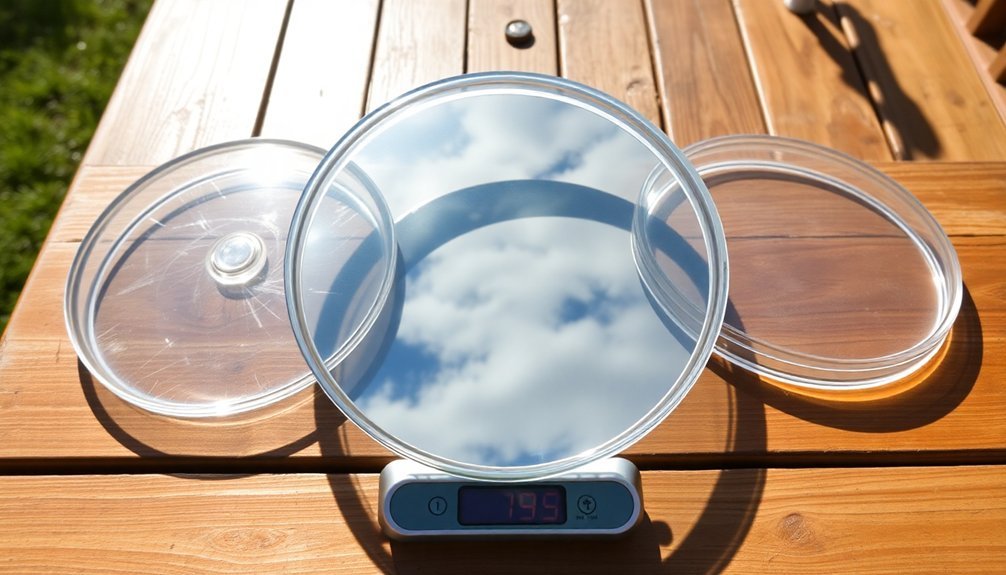
When it comes to solar cooking, glass stands out as the premier lid material due to its exceptional heat-trapping abilities.
You'll find that glass allows ultraviolet and visible light to pass through while blocking infrared radiation from escaping, creating an efficient thermal barrier.
Your solar cooker's effectiveness relies on glass's unique properties. It lets sunlight enter and strike dark-colored surfaces, where it converts to heat energy that can't escape.
You'll achieve cooking temperatures between 65°C and 400°C, as the glass lid prevents hot air from mixing with cooler outside air. This sealed environment means you won't experience burning or overcooking, making it perfect for various cooking methods. Similar to a car with closed windows, the glass traps heat energy effectively through this greenhouse effect.
When paired with dark, matte-finished pots, you're maximizing solar energy absorption and retention for ideal cooking results.
Understanding Tempered Glass Benefits
When you're cooking with tempered glass lids, you can trust their exceptional ability to withstand high temperatures without cracking or shattering into dangerous shards.
You'll appreciate how tempered glass maintains its structural integrity even when exposed to sudden temperature changes and extreme heat during cooking sessions. This resilience comes from being four times stronger than standard glass.
Your tempered glass lids will also reliably protect your food through various weather conditions, whether you're cooking indoors or using them for outdoor solar cooking applications.
Safety Under High Heat
Since cooking often involves intense heat, understanding tempered glass's safety features is essential for home chefs.
You'll find that tempered glass can handle temperatures up to 500°F, making it suitable for most cooking tasks. The special manufacturing process, which involves rapid cooling after high-temperature heating, gives the glass its exceptional strength and heat resistance. The stringent quality checks during production ensure the glass performs reliably and safely in high-heat conditions.
When you're cooking, you'll appreciate that tempered glass won't shatter easily from bumps or knocks. If it does break, it'll crumble into small, rounded pieces rather than dangerous shards, protecting you from serious injury.
However, you should be cautious about exposing the glass to temperatures beyond 500°F, as extreme heat can cause thermal shock. Remember that sudden temperature changes can create stress within the glass, potentially leading to breakage.
Durability Against Weather Impact
Thanks to its specialized manufacturing process, tempered glass offers exceptional durability against various weather conditions.
You'll find that its molecular structure, created through rapid heating and cooling, makes it highly resistant to temperature fluctuations and environmental stresses.
When you're cooking outdoors, you won't need to worry about your tempered glass lid deteriorating from rain or extreme temperatures.
Unlike early glass windows that would stain from smoke and grease, modern glass-ceramic materials like SCHOTT NEXTREMA® stay clean and clear. They're nonporous, which means smoke and splatter won't permanently mar their surface.
You'll appreciate how these lids maintain their clarity and strength over time, requiring only simple cleaning to keep them in top condition.
Their resistance to expansion and contraction also guarantees long-term reliability in any weather.
Plastic Wrap Cost Effectiveness

While you'll find plastic wrap to be an affordable initial investment at under $5 for household varieties or $30 for restaurant-grade options, you need to factor in the ongoing costs of frequent replacements.
You can maximize cost efficiency by opting for commercial-grade wraps that offer better durability and coverage per dollar, despite their higher upfront price.
The long-term value becomes apparent through reduced replacement frequency and improved preservation capabilities, though you should weigh these benefits against the environmental costs of disposable plastic materials.
Cheap Yet Effective Option
Although plastic wrap may not be the most durable lid material for solar cooking, it offers an affordable entry point for those wanting to experiment with solar ovens.
You'll find it creates a basic greenhouse effect by allowing sunlight to pass through while trapping some heat inside your cooker.
- You can easily find plastic wrap at any grocery store for minimal cost
- It's simple to install and replace when needed
- You don't need special tools or skills to work with it
- You can use it for temporary or emergency solar cooking setups
While plastic wrap won't match the performance of materials like Lexan or plexiglass, it's a practical choice if you're just starting out.
Just remember it's not suitable for high-temperature cooking and you'll need to replace it more frequently than other materials.
Replacement and Installation Costs
The cost-benefit analysis of plastic wrap as a solar oven lid material reveals both advantages and drawbacks.
You'll find the initial investment quite modest, with a standard box costing around $4.69 for 200 feet, while restaurant-grade options offer better value at $30 for 2,000 feet.
Installation won't strain your budget since you'll only need basic tape to secure the plastic wrap.
There's no need for specialized tools or hardware, making it a straightforward DIY solution.
However, you should factor in frequent replacement costs, as plastic wrap's durability is limited in solar cooking conditions.
It's prone to melting, warping, and tearing, which means you'll need to replace it regularly.
Plus, since it can't be recycled, you're contributing to environmental waste with each replacement.
Long-term Cost Analysis
Analyzing plastic wrap's long-term costs reveals a more complex financial picture than its low initial price suggests. While a basic box costs just $4.69 for 200 feet, you'll need to keep buying it since it's single-use.
Restaurant-grade wrap offers better value at $30 for 2,000 feet, but you'll still face ongoing purchases.
- You'll spend more over time with plastic wrap due to continuous replacement needs
- Environmental costs add up through waste management and non-biodegradable disposal
- Restaurant-grade options provide better performance and durability per dollar
- Alternative materials like beeswax wraps become more cost-effective after a year of reuse
When considering these factors, plastic wrap's seemingly affordable price tag doesn't tell the whole story.
The cumulative costs of regular purchases and environmental impact make reusable alternatives worth considering for your long-term kitchen needs.
Advanced Polycarbonate Solutions
Advanced polycarbonate materials present three key advantages for cooking lid design: exceptional durability, superior transparency, and high thermal resistance. You'll find these materials particularly effective when you're looking for lightweight yet robust solutions for your cooking needs.
| Feature | Benefit | Consideration |
|---|---|---|
| BPA-free grades | Safe food contact | Must verify FDA compliance |
| UV-stabilized | Extended lifespan | Higher initial cost |
| Flame-retardant | Enhanced safety | Specific cleaning required |
When selecting polycarbonate lids, you'll need to confirm you're choosing FDA-approved grades for direct food contact. The material's excellent impact resistance makes it ideal for portable cooking setups, while its high glass shift temperature lets you cook safely at elevated temperatures. Remember to use compatible cleaning agents to maintain the lid's integrity and transparency over time.
Heat Retention Fundamentals
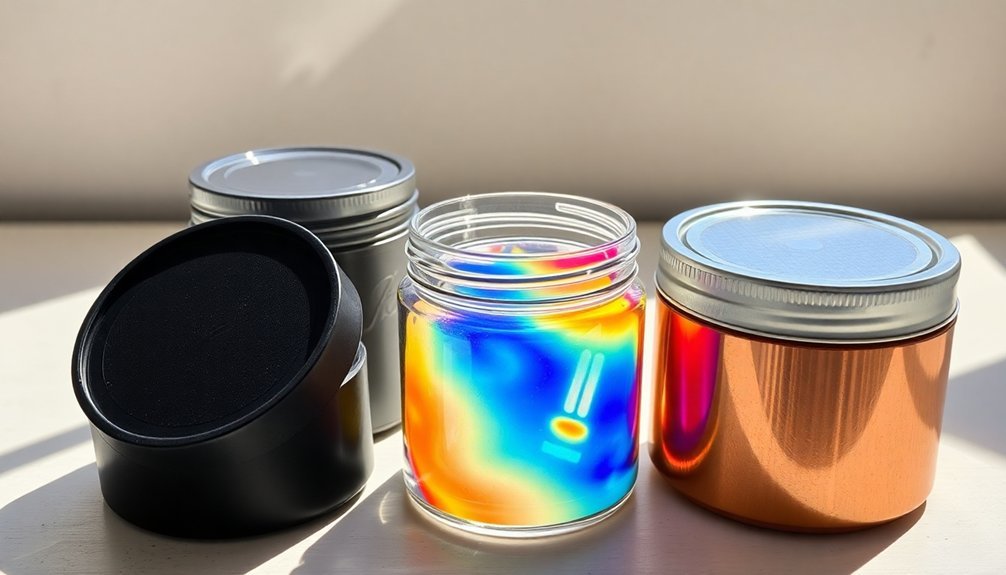
Understanding heat retention fundamentals starts with mastering three critical heat transfer mechanisms: conduction, convection, and radiation.
These principles work together to maximize your cooking efficiency when using solar power, especially with proper lid selection and usage.
To optimize heat retention in your solar cooking setup, focus on these key elements:
- Minimize air space between food and lid to maintain consistent temperatures
- Choose lids with tight-fitting seals to prevent heat from escaping
- Select materials that balance heat conductivity with insulation properties
- Position reflective surfaces strategically to concentrate sunlight onto your cooking vessel
Clear Materials Matter
Building on heat retention principles, the selection of clear materials plays a central role in solar cooking success.
You'll find several effective options, from budget-friendly plastic wrap to durable tempered glass. While plastic wrap and ziplock bags are inexpensive choices, they're less stable in windy conditions and don't last as long.
For better durability and performance, you'll want to evaluate UV-resistant materials like Lexan plastic sheets or tempered glass.
These materials excel at transmitting sunlight while trapping heat through the greenhouse effect. If you're working with a shoebox-sized cooker, overhead transparencies work well. For larger designs, opt for acrylic sheets or glass.
Securing Your Solar Oven Lid
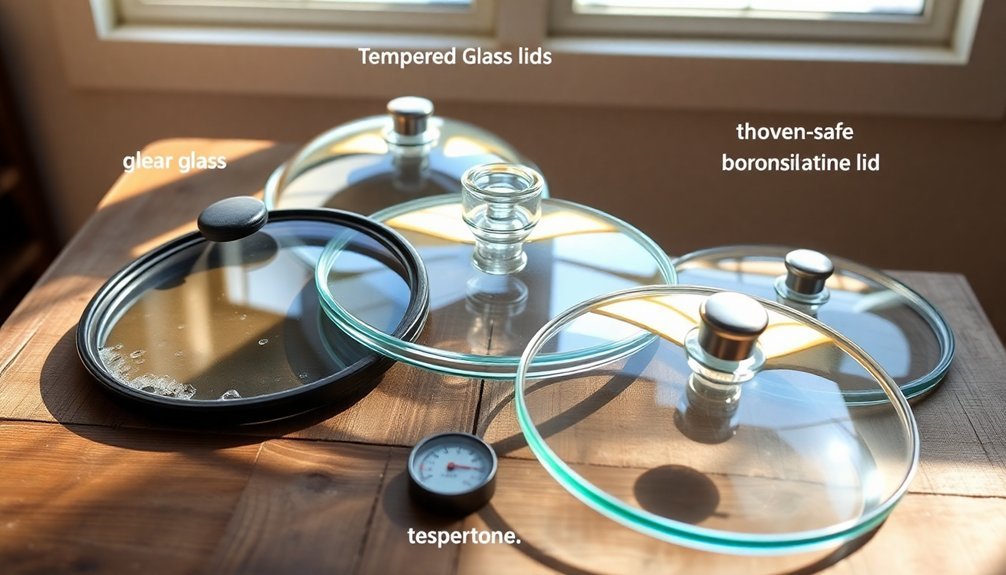
Your solar oven lid needs a tight seal to maintain consistent cooking temperatures, so you'll want to carefully secure all edges with heat-resistant tape and guarantee there are no gaps where heat can escape.
To protect against unexpected weather conditions, you'll benefit from installing sturdy fasteners like stainless steel hinges or UV-resistant clasps that can withstand outdoor elements.
For maximum efficiency, combine these securing methods with proper insulation materials around the lid's perimeter to create an airtight cooking environment.
Tight Seal Methods
While creating an effective solar oven depends on many factors, obtaining a tight seal on your lid plays an essential role in maintaining ideal cooking temperatures.
You'll want to guarantee proper heat retention while allowing minimal steam release to prevent pressure buildup.
Here's what you need to know about creating an effective seal:
- Apply two layers of clear plastic wrap across your lid opening, securing edges with shipping tape or black electrical tape.
- Line the lid's interior with smooth aluminum foil to maximize sunlight reflection and heat retention.
- Use metal office binder clips to tighten loose-fitting lids, but don't seal completely.
- Create small vents using a stick between the glass and oven edge to prevent excessive steam buildup.
Remember to balance heat retention with safety by allowing some controlled steam release during cooking.
Weather-Resistant Lid Fasteners
Securing a solar oven lid against weather elements requires more than just a basic seal – you'll need reliable fasteners that can withstand various outdoor conditions.
You can use screws and nails for permanent installations, especially when attaching side rails or wooden frames to create a sturdy structure.
For DIY solutions, opt for white school glue and clear tape to secure aluminum foil and plastic components.
These adhesives work well for binding cardboard corners and keeping reflective materials in place.
If you're looking for adjustable options, try brass paper fasteners or binder clips, which allow you to modify the lid's position as needed for ideal sun exposure.
Metal clips are particularly effective for maintaining proper alignment and securing strings when you're using a solar funnel design.
Temperature Considerations For Materials
Understanding temperature limits is essential when selecting lid materials for your cookware. Each material has unique thermal properties that affect your cooking performance and safety.
Silicone lids offer flexibility and can withstand temperatures from -40°C to 260°C, while borosilicate glass handles up to 243°C with better thermal shock resistance.
- Silicone provides excellent versatility and won't slip, making it perfect for various pot sizes.
- Glass lids let you monitor cooking progress but require careful handling to prevent thermal shock.
- Stainless steel heats and cools quickly, ideal for precise temperature control.
- Ceramic and glass materials retain heat longer, which can extend cooking times.
When choosing your lid material, consider both the maximum temperature resistance and how quickly it responds to temperature changes.
You'll want materials that match your specific cooking needs and safety requirements.
Greenhouse Effect In Action
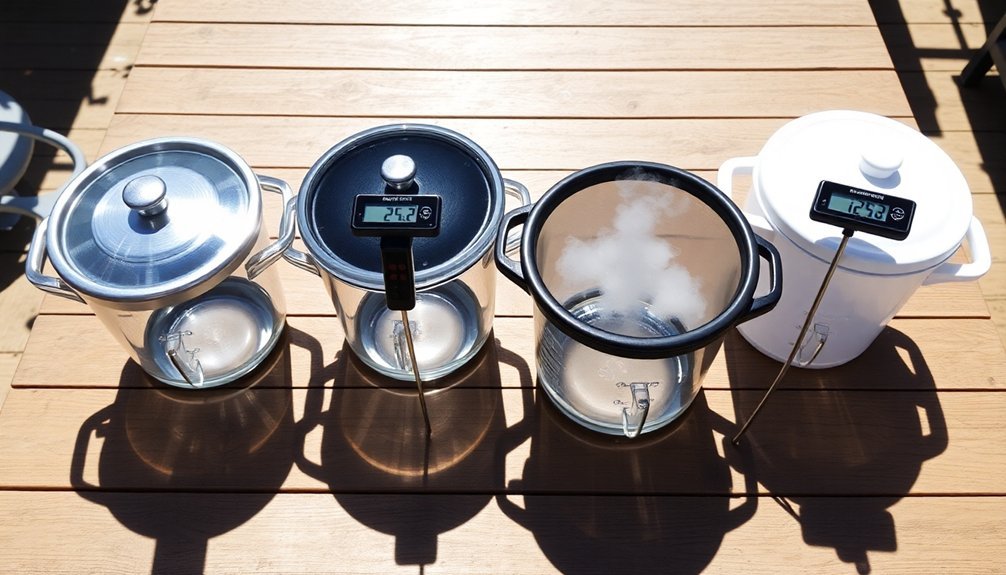
Just as a greenhouse traps warmth from the sun, your pot lid creates a similar effect during cooking. The transparent lid allows sunlight to pass through and strike the dark interior of your cooking vessel. As the black surface absorbs this light, it converts it into heat energy that remains trapped inside by the lid.
You'll see this process amplified when you use clear plastic or glass lids that act like the Earth's atmosphere, letting light in while preventing heat from escaping.
To maximize this effect, you can position reflective surfaces, like aluminum foil, to direct more sunlight into your cooking vessel. The trapped heat continues to build up, raising the internal temperature and cooking your food effectively.
This greenhouse effect works best when you place your setup in direct sunlight with proper insulation around the sides.
Durability And Material Longevity
While the greenhouse effect determines how well your lid traps heat, the material's durability decides how long it'll maintain this efficiency.
You'll want to take into account both immediate performance and long-term reliability when selecting your lid material.
Key durability factors to watch for:
- Polycarbonate offers excellent UV resistance and strength, making it ideal for long-term use
- Aluminum foil tape delivers consistent performance and withstands regular cleaning
- Heat-resistant plastic bags work for about 10 uses before becoming brittle
- Aluminized polycarbonate film scratches easily and loses its coating over time
When maintaining your lid material, store it away from moisture and animals.
Regular cleaning is essential to maintain reflective efficiency, but be gentle to avoid scratching surfaces.
Take into account your local climate, as environmental conditions can greatly impact material longevity.
Monitoring Your Solar Cooking Progress
To achieve consistent results in solar cooking, precise monitoring of temperature, solar position, and weather conditions is essential.
You'll need to use thermocouples and data loggers to track your cooking temperatures accurately, while mobile apps can help you monitor readings from anywhere.
Keep an eye on solar position updates every 5-15 minutes using advanced tracking systems that combine satellite data with local weather models.
You'll get highly localized information to optimize your cooker's placement. Track key metrics like solar irradiance and ambient temperature to calculate cooking efficiency, and use standardized equations to determine cooking power.
Set up weather alerts to notify you of changing conditions that might affect your cooking.
The system will recommend adjustments to cooker position and suggest alternative cooking methods when necessary.
Maximizing Heat With Lid Design
The right lid material plays an essential role in maximizing your solar cooker's heat retention and efficiency. When selecting your lid, you'll want to take into account both durability and temperature tolerance.
Tempered glass offers the best performance for high-heat cooking, while clear plastic wrap provides a budget-friendly alternative for lower temperatures.
To maximize heat retention with your lid design:
- Use double layers when possible – whether it's double-pane glass or multiple sheets of plastic wrap
- Seal all gaps around the edges with tape to prevent heat escape
- Choose UV-resistant materials like Lexan if you're planning frequent outdoor use
- Make sure your lid material can withstand your intended cooking temperatures without melting or degrading
Remember to adjust your lid angle throughout the day to capture ideal sunlight for efficient cooking.
Frequently Asked Questions
Can You Stack Multiple Solar Ovens to Increase Cooking Temperature?
You shouldn't stack solar ovens as it'll reduce efficiency and create safety risks. The upper ovens would block sunlight from reaching lower ones, and the combined weight could make them unstable.
How Do Different Lid Colors Affect Cooking Performance?
You'll get better cooking performance with dark-colored lids since they absorb more heat quickly. Light-colored lids reflect sunlight away, reducing your oven's temperature. Black lids are your best choice for maximum heat absorption.
Do Magnetic Lid Attachments Work Well for Solar Ovens?
You shouldn't use magnetic lid attachments for solar ovens. They won't provide the stability you need and aren't proven to work well. Instead, stick with traditional springs or hinges for secure, reliable performance.
What's the Maximum Wind Speed a Solar Oven Lid Can Withstand?
You'll want your solar oven lid to withstand winds up to 2.5 m/s, though you shouldn't test beyond this limit. For safety and ideal performance, it's best to use your oven in winds under 1.0 m/s.
Can Solar Oven Lids Be Effectively Cleaned With Standard Glass Cleaners?
You shouldn't use standard glass cleaners on solar oven lids as they can damage sensitive materials. Instead, use mild detergents with a soft cloth to clean your lid and avoid harsh chemicals that cause degradation.
In Summary
You'll find that choosing the right lid material dramatically affects your solar cooking success. Whether you opt for tempered glass's durability, plastic wrap's affordability, or polycarbonate's lightweight strength, understanding heat retention is key. Remember to monitor your food through transparent materials and maintain proper seals. By selecting the best lid for your needs, you're maximizing your solar cooker's efficiency and ensuring better cooking results.

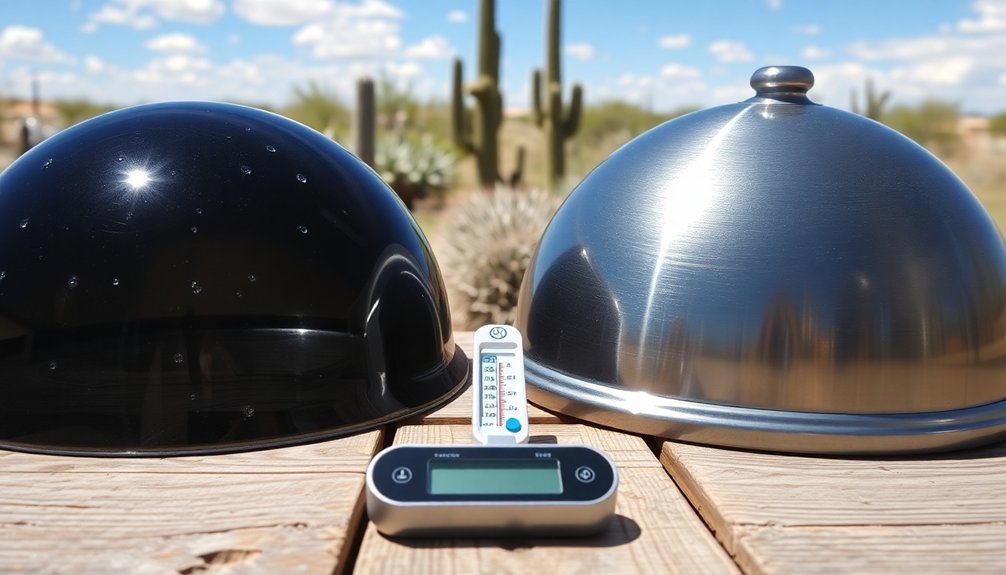
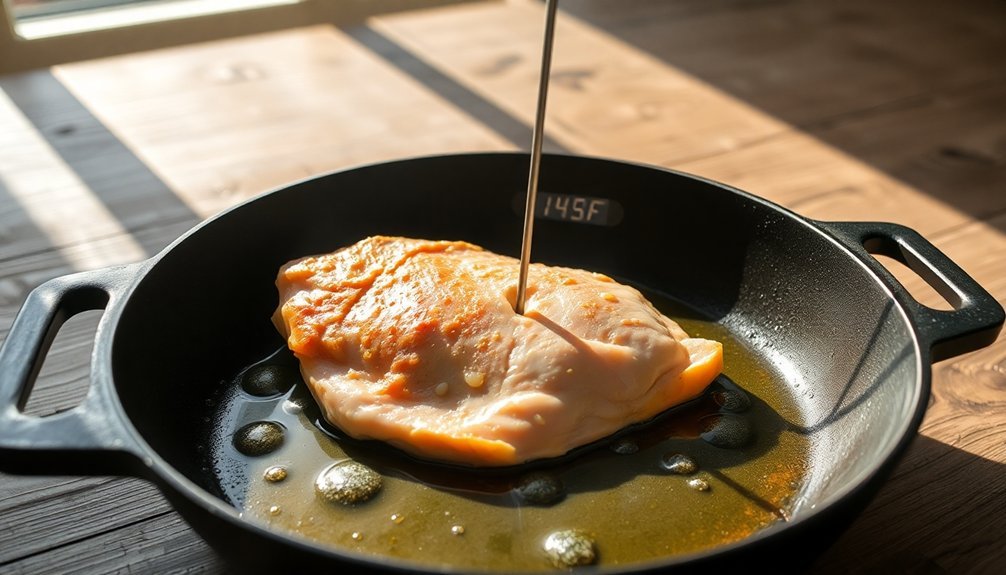
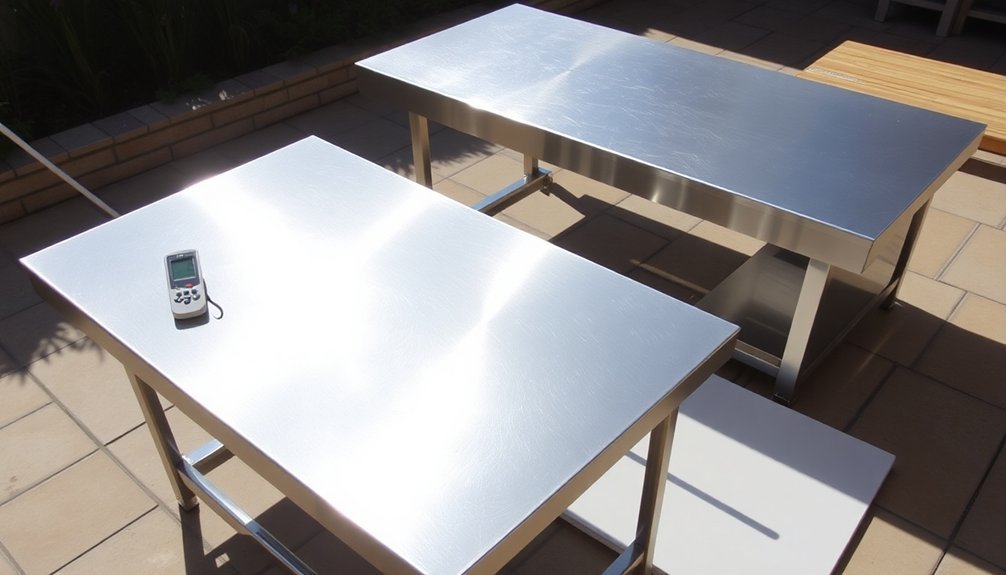
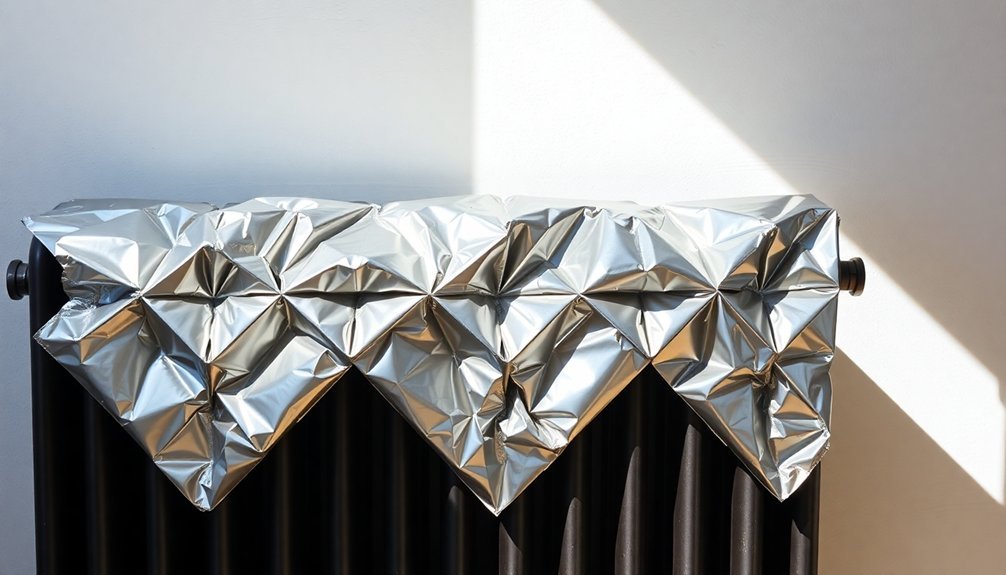
Leave a Reply